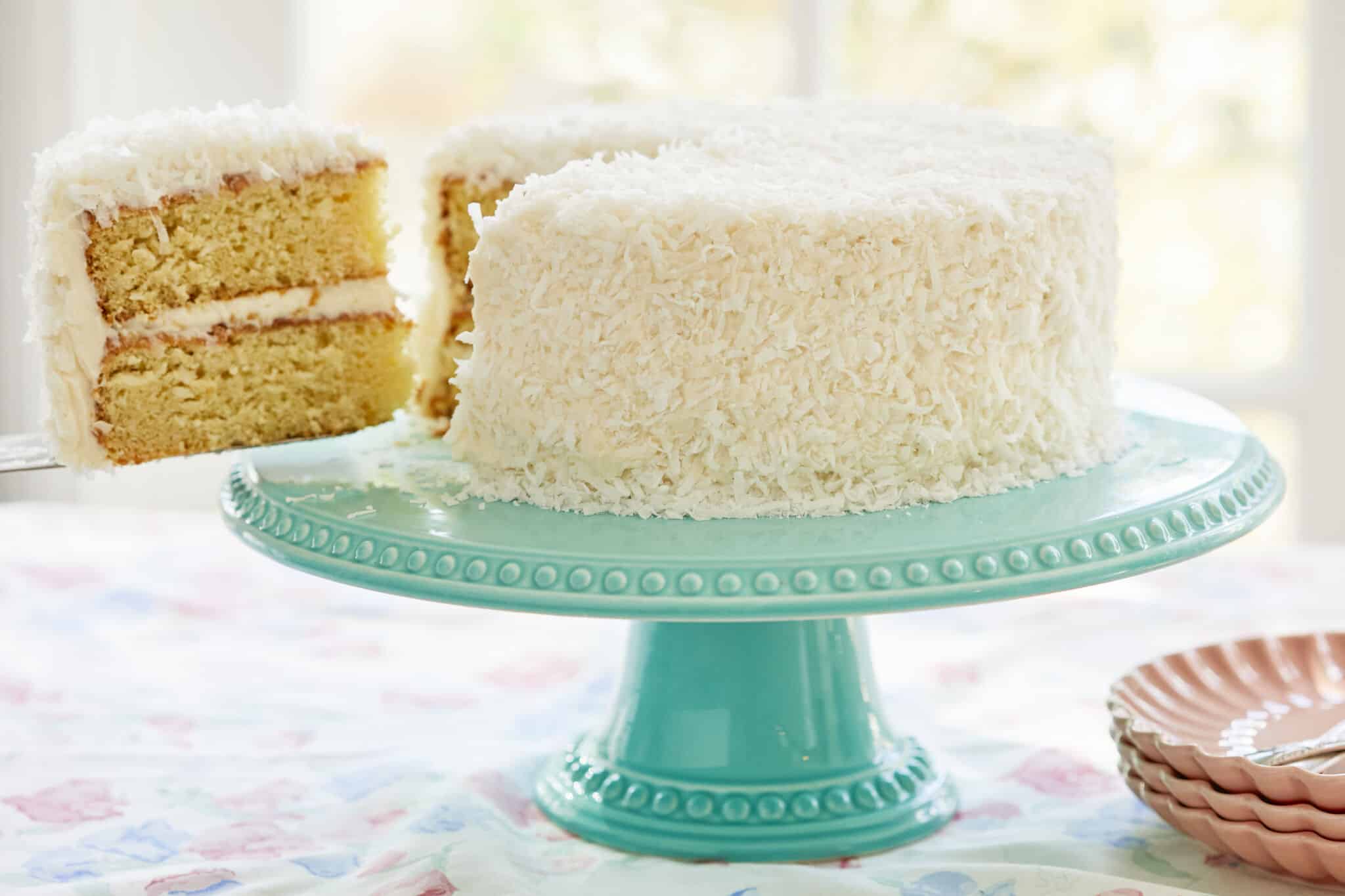
This post may contain affiliate links. Please see my full disclosure for details.
Hi Bold Bakers!
WHY YOU’LL LOVE THIS RECIPE: My Incredibly Moist Coconut Cake recipe is the epitome of an irresistible coconut dessert! In every mouthful you get tender, fluffy white cake elevated by the delectable coconutty flavors from the coconut flakes and coconut extract. Smooth and tangy Cream Cheese Frosting adds richness and slightly sweet, crunchy shredded coconut tops it all off–it’s a coconut party!
Table Of Contents
- What Is Coconut Cake?
- Why Add Buttermilk To Cakes?
- Tools You Need
- Important Ingredients for a Moist Coconut Cake and Why
- How To Make a Moist Coconut Cake
- Gluten-Free Coconut Cake
- Can I Make Coconut Cake In Advance?
- How To Store Moist Coconut Cake
- FAQs
- Gemma’s Pro Chef Tips
- More Coconut Dessert Recipes
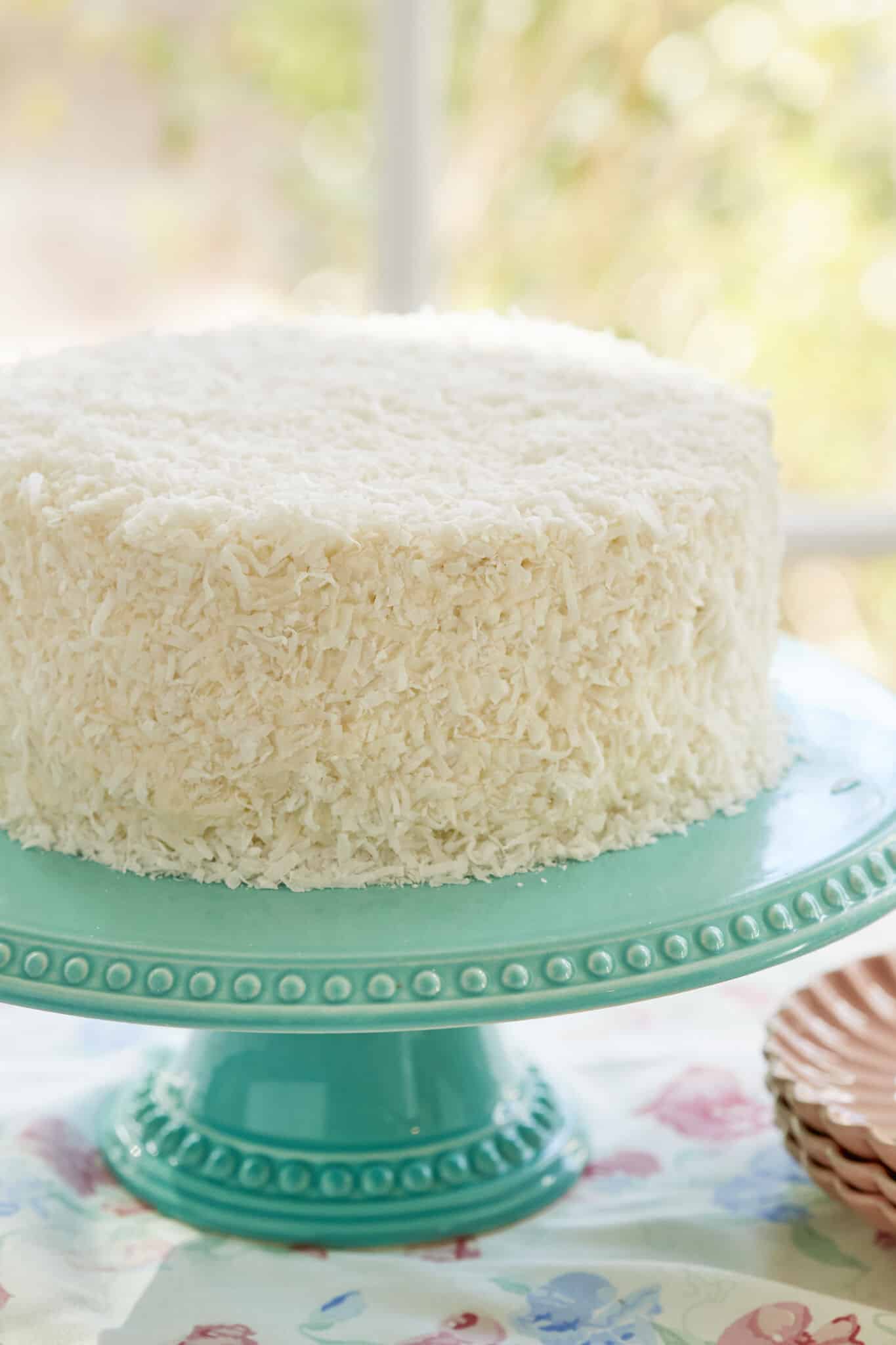
What Is Coconut Cake?
Coconut Cake is a type of white or yellow cake frosted with white frosting and decorated with coconut flakes. The ingredients typically include flour, sugar, eggs, butter, leaveners, coconut milk, and coconut flakes. However, there are many variations of this cake with different baking styles and ingredients.
Specifically in my recipe, we are making a white cake infused with coconut extract and buttermilk as well as frosted with my delicious Best-Ever Cream Cheese Frosting.
This popular dessert is believed to originate from the Southern region of the United States. It’s especially popular in states like Florida and Georgia, where coconuts are more prevalent and have been incorporated into numerous other dishes and treats.
Why Add Buttermilk To Cakes?
This Coconut Cake is incredibly moist for a reason! Buttermilk is the secret to any fluffy, tender and moist cake and you can easily make it at home using my Homemade Buttermilk recipe.
Tools You Need To Make Coconut Cake:
- Measuring cups and spoons
- Two 8-inch (20 cm) round cake pans
- Parchment paper
- Stand mixer with a whisk and paddle attachments
- Alternatively, a large mixing bowl and handheld electric mixer or a bowl and a whisk
- Mixing bowls
- Silicone spatula
- Large metal spoon
- Wooden skewer or toothpick
- Wire cooling rack
- Serving plate or cake stand
- Offset spatula
Important Ingredients for a Moist Coconut Cake and why
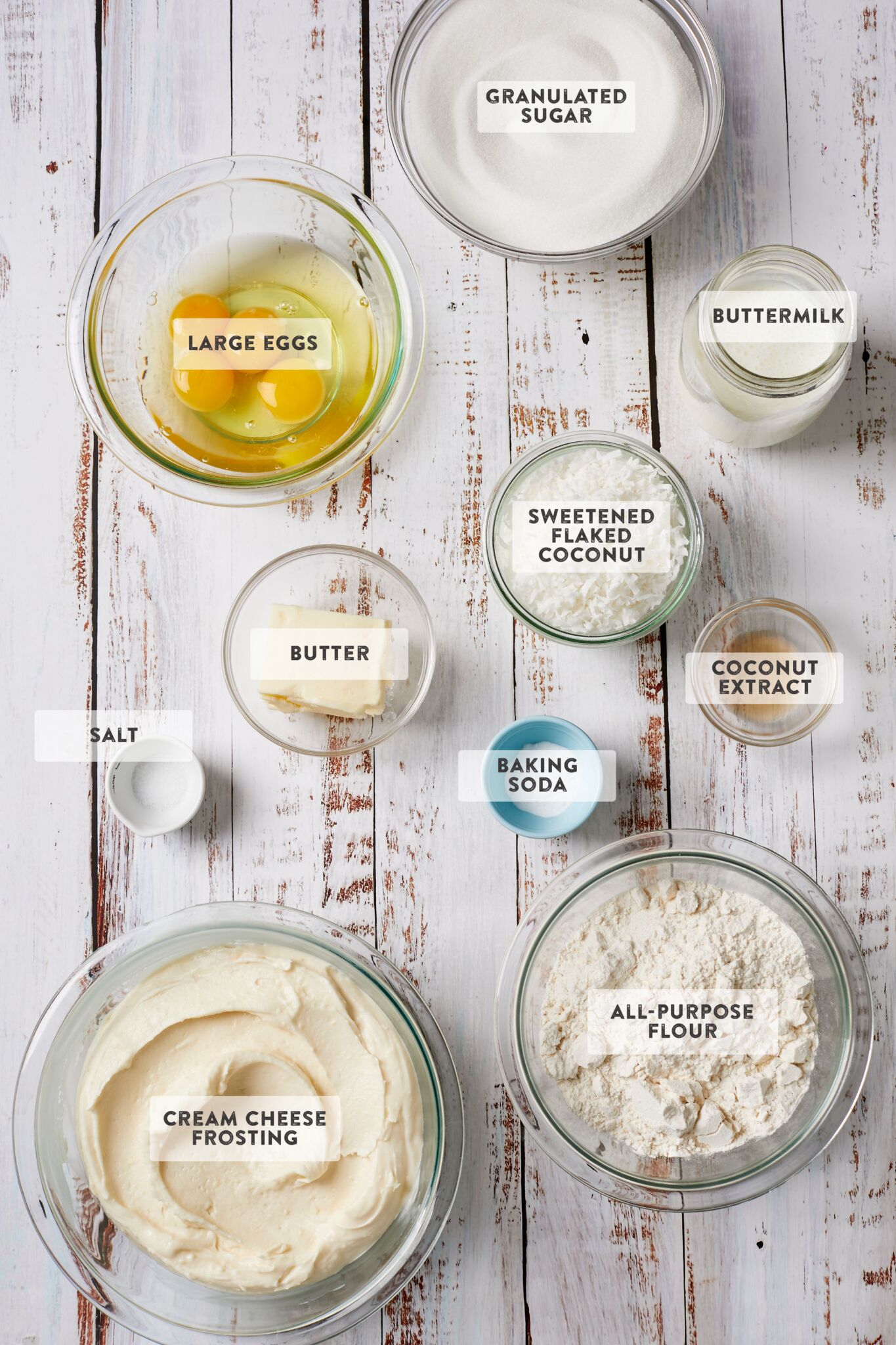
For The Coconut Cake:
-
Eggs:
- Eggs always need to be at room temperature in baking unless specified otherwise. Room-temperature eggs will set this recipe on the right track with a smooth and cohesive cake batter.
- Eggs enrich flavors, provide an emulsifier from the yolks to bind all ingredients homogeneously, and incorporate and retain with egg whites to make baked goods fluffy and soft.
- While separating the egg yolks from the whites, make sure the bowl for egg whites is dry and clean without any grease or water. Otherwise, the egg whites will not whip up and the cake will be dense.
-
Butter:
- Butter contains around 80% milk fat which adds richness to cakes.
- Softened butter can incorporate and retain air when creamed with sugar. The air expands under heat to add lightness, yielding a tender texture.
- Salted butter adds extra flavor and is what I always use, but unsalted butter works too.
-
Granulated sugar (aka White Sugar):
- Sugar sweetens cakes.
- Sugar binds easily with water, not only locking in water to make baked goods moist, but also inhibiting gluten formation to cakes soft.
- Sugar rubs against fat from softened butter during creaming, creating air pockets to incorporate air. In the meantime, sugar also coats air pockets to prevent them from drying out, retaining air to make cakes light and melt-in-your-mouth tender.
-
Coconut extract:
- Natural coconut extract is a flavoring made from the flesh of coconuts. Its nutty and sweet flavor will boost the coconut flavor in this cake.
- Make your own extracts using my recipe for Homemade Extracts.
-
Baking soda:
- Baking soda doesn’t contain acid, so it activates ONLY when mixed with acidic ingredients like buttermilk or lemon juice.
- Baking soda reacts with acid from buttermilk and also eggs to release gas, which creates air pockets to make cakes rise.
- Baking soda also reacts with hot sugar to give the cakes extra flavor.
- Buttermilk:
- Buttermilk is a tangy, acidic dairy product made by adding bacteria culture to milk. It’s an essential ingredient to your cake because it adds tons of moisture, tangy flavor, and tenderness.
- The acid will react with a raising agent to release gas to yield a good rise and break down protein in flour to make baked goods softer. In this way, the protein won’t have big holes so moisture will be locked in the cake.
- If you don’t have buttermilk, you can easily make a substitute using my How to Make Buttermilk Substitute recipe. So make my plain yogurt recipe or sour cream recipe to replace buttermilk.
For the Frosting and Topping:
- Cream cheese frosting:
- Cream cheese frosting perfectly complements the sweet cake because not only it’s lighter than buttercream but also it adds a tangy flavor. You can make my Best Ever Cream Cheese Frosting recipe at home.
- For an added challenge, make the easiest Cream Cheese recipe from scratch!
-
Coconut flakes:
- Coconut flakes will not only add more coconutty goodness to your cake but also add some crunchy texture and sweetness.
- For the best results, use sweetened coconut flakes.
How To Make Coconut Cake
Make The Coconut Cake:
- Prep:
- Always preheat your oven.
- Buttering and lining pans with parchment paper ensures that your cake won’t stick to the sides of the pan and makes it easier for you to take your cake out without breaking the bottom.
- Incorporating air to lighten the cake:
- Make sure to whip the egg whites in a dry and clean bowl to stiff peaks which become glossy and stay sharp at the ends without curling over when the whisk is lifted.
- Cream the butter and sugar until light and fluffy first to build an aerated structure to hold the remaining ingredients.
- Add the egg yolks one at a time to followed by a coconut extract. In the meanwhile, make sure to scrape down the sides of the bowl a few times to ensure even mixing.
- Combining:
- Take care not to over mixer a cake batter otherwise the cake would turn out tough and rubbery.
- Alternately add the dry ingredients and the buttermilk into the butter mixture, be sure to scrape down the sides as you go for even mixing.
- Gently fold in the egg whites using a thin-edged metal spoon until JUST combined.
- Do not over bake the cake. Bake until a wooden skewer comes out clean or if the edges look nice and golden brown.
- Do not remove from the pant to a wire rack g too early before it cools completely. the remains heat will full set the cake properly to prevent any breakage.
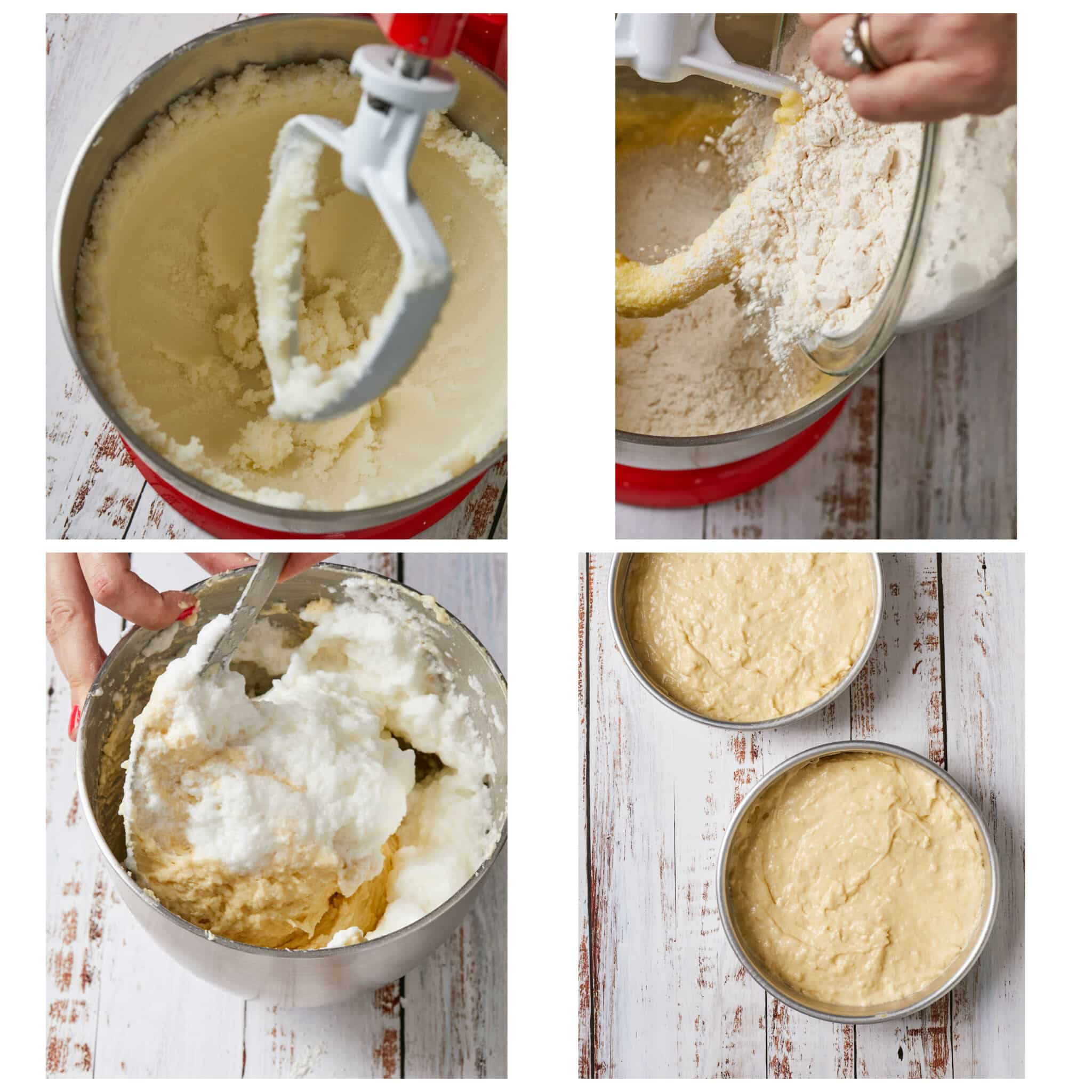
Decorate The Coconut Cake:
Don’t worry if there are cracks or lumps in your frosting – you can cover it with coconut flakes!
Or, you can check out my post How to Do a Crumb Coat for a very professional result.
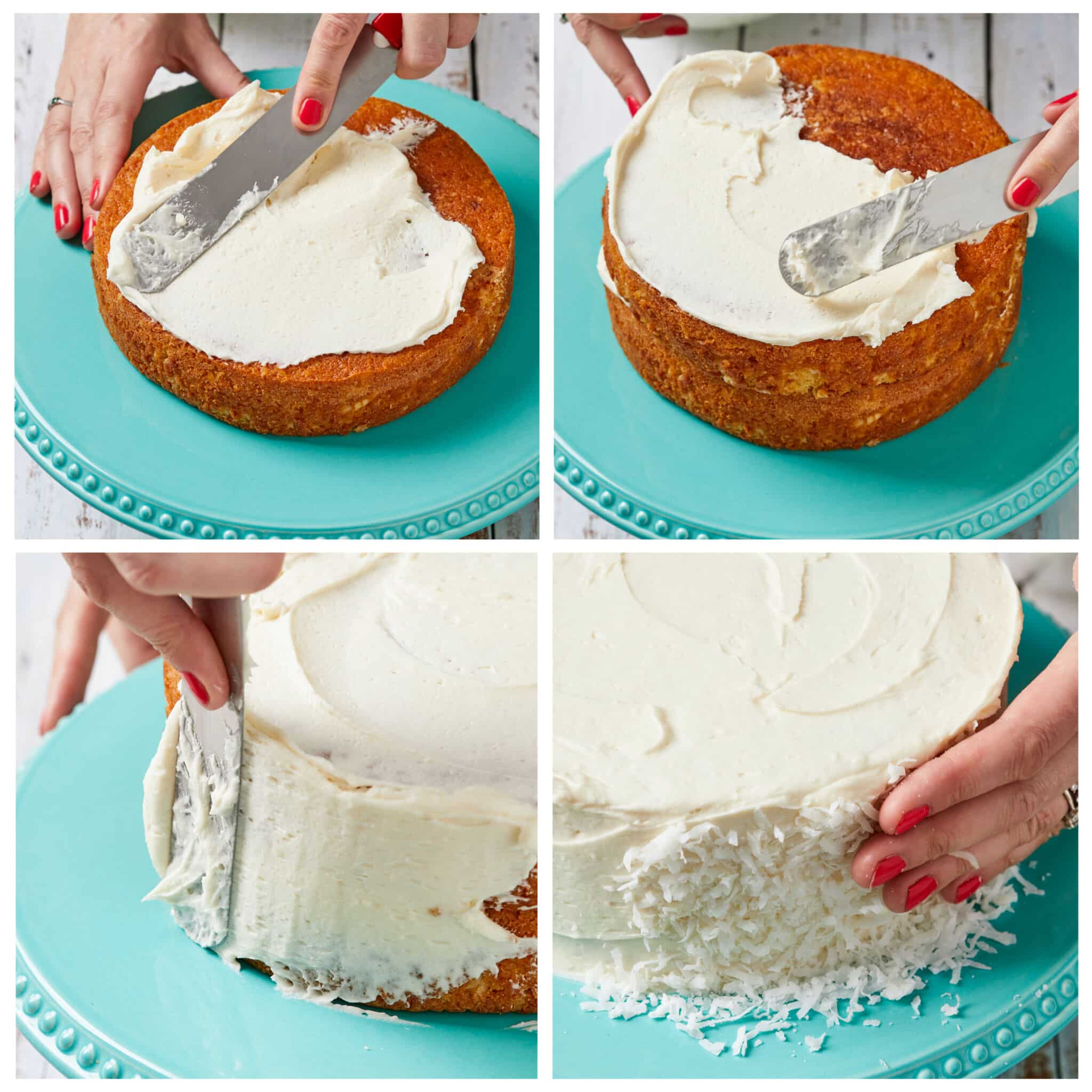
Gluten-Free Coconut Cake
I want all of my Bold Bakers to be able to try this incredibly moist Coconut Cake. Good news! For those of you who have gluten allergies or want to try a gluten-free Coconut Cake recipe, it’s very simple. Replace the all-purpose flour with a Gluten-Free All-Purpose Flour Blend, Almond Flour, Oat Flour, or coconut flour.
- Substitute Gluten-Free All-Purpose Flour Blend for all-purpose flour at a 1:1 ratio.
- Substitute almond flour starting at 1:1 for all-purpose (white) flour. More resting time before baking will help hydrate almond flour to bind all ingredients better, or ½ – 2 tsp xanthan gum or cornstarch in each cup of almond flour will also work as a binding agent.
- A good starting point is to substitute ¼ cup (1 ounce) of coconut flour for every cup of almond flour. You will also need to add 1 egg for every 1/4 cup of coconut flour used in addition to the eggs called for in the original recipe.
A good rule of thumb when substituting flour is to hold back some liquid by using up to three-quarters of the required amount in one go and adjust accordingly to get the same consistency. This way, you can achieve a smooth cake batter even with different flour textures.
Can I Make Coconut Cake In Advance?
Yes, you can make the cake batter in advance but the result will be denser.
- Keep this in mind: any baking soda-leavened recipe, it’s best to bake off right away to give your baked goods the best rise! Storing a raw batter will lessen baking soda’s effectiveness, and will affect the softness because baking soda activates immediately when mixed with acidic liquid to release gas.
- You can use my recipe to make your Cream Cheese Frosting and store it in an airtight container in the refrigerator for 4 to 5 days.
How To Store Coconut Cake
This Coconut Cake is so delicious you’ll be coming back for seconds. To properly store your leftovers, here are some methods:
- Room temperature: Store slices of your Coconut Cake at room temperature in an airtight container or well-covered with plastic wrap for up to 2 days.
- Refrigerator: For longer storage, store your cake in the refrigerator and allow it to come to room temperature before serving.
- Freezer:
- Freeze sliced cakes in one layer on a flat tray until solid. Then wrap cake slices individually with plastic wrap or aluminum foil and transfer them into an airtight container or freezer-safe bag.
- You can freeze your cake for up to 3 months, but the texture and flavor may not be as good as when fresh.
- To thaw your frozen cake, remove the slices from the freezer and let it thaw at room temperature for a couple of hours. You can also thaw the cake in the refrigerator overnight and bring it back to room temperature closer to serving.
FAQs
Can I use unsweetened coconut flakes? How do I sweeten unsweetened coconut?
This recipe calls for sweetened coconut flakes because it adds more sweetness and flavor to your cake batter. However, if you only have unsweetened coconut flakes on hand, no worries! Here’s how to sweeten unsweetened coconut flakes:
- Place your coconut flakes, about a pound or so, in a Ziplock bag with 2 tablespoons of powdered sugar.
- Shake the bag, making sure to coat all the flakes, and it’s ready to use in your batter!
How can I enhance my coconut flavor?
When making a Coconut Cake, you want the flavor of coconut to pop. In this recipe, I include coconut flakes and coconut extract throughout the cake as well as the decorations, but here are some ways to enhance them:
- Coconut flakes: The best way to enhance the coconut flavor and texture is to toast your coconut flakes.
- Ppreheat your oven to 325°F (165°C) and place the shredded coconut on a parchment-lined baking sheet. Bake, stirring frequently to prevent burning, for 5 to 10 minutes until the flakes are light golden brown.
- Feel free to toast your flakes in coconut oil for an extra boost of coconut flavor!
- Coconut extract:
- Use high-quality natural coconut extract that is made of real coconut flesh instead of artificial chemicals for the best coconut flavor.
- You can also make your own extracts using my Homemade Extract recipe.
- You can also add a teaspoon coconut extract into your frosting to make Coconut Cream Cheese Frosting!
- Coconut milk: While I recommend buttermilk for this recipe for the extra moisture and lightness, you can use coconut milk if you’re looking to make an extra nutty and sweet cake.
Why did my cake sink in the middle? How to prevent a sinking cake?
Sometimes, you’ll find that your cake sags or sinks in the middle after baking. This can happen for a few reasons:
-
High temperature
When the oven runs high, the outside gets cooked to harden too fast, preventing the inside from rising more.
-
Underbake
- This happens when an oven runs low, one opens the door in the early baking stage or the cake isn’t baked for long enough. The ingredients, especially the leavening / raising agent don’t have enough time to create gas to hold up the shape.
- Bake cakes until no wetness on top, firm to touch in the center, the edge pulls away from the mold a little bit or a toothpick inserted comes out clean.
- To know your oven well: https://www.biggerbolderbaking.com/toaster-oven-otg-baking-guide/ , https://www.biggerbolderbaking.com/guide-to-knowing-your-oven/
-
Failed raising agent
- When baking soda expires, it won’t be active enough to create so much gas, so the cake won’t rise.
- If you sit the batter too long, it will also lose its effectiveness.
-
Over leavened
- When too much leavening / raising agent is used, the gas/air it created during baking surpasses the cake’s capacity — its structure cannot hold that much air so collapses.
-
Unbalanced consistency(usually too wet here)
- Flours in different places behave in different ways, depending on how, where, when and the type of wheat grain being milled. They absorb liquid differently.
- Hold back some liquid by using up to three-quarters of the required amount in one go and adjust it accordingly to get the same consistency as the recipe.
-
Over-mixing
- Bring ingredients together (especially while folding dry into wet ) until just combined/incorporated, otherwise, the air will be knocked out.
-
Dramatic temperature change after baking during cooling
- Letting it cool down in a very drafty spot will cause it to sink before the reaming heat inside the cake stabilizes the structure.
- Let cakes cool in the pan for around 15 minutes or completely to help the cake set properly.
How to get coconut flakes to stick to my cake?
One of the best parts about this cake is the decorations! Coconut flakes can be a bit tricky to work with because they can get messy and they may not properly stick. I recommend taking it slow:
- Use an offset spatula to cover a small section of the cake with Cream Cheese Frosting and immediately add your coconut flakes. Keep repeating until your entire cake is covered.
- Waiting too long to add the coconut may cause your frosting to dry up.
- If some spaces look sparse, go in with some more coconut flakes and gently press them in.
- If you find the coconut flakes are sticking to your hand, use some parchment paper to gently press the flakes into the top and sides of the cake.
Gemma’s Pro Chef Tips:
- Room-temperature ingredients: Always use room-temperature ingredients when making cakes for the most even mixing and best rise.
- Make it more tropical: For an extra tropical surprise, mix ¼ cup (1¼ oz/35 g) of drained, chopped canned pineapple with ½ cup (4 oz/115 g) of cream cheese frosting between the cake layers.
- A Thin-Edged Metal Spoon: Using a thin-edged metal spoon instead of a regular spatula will minimize knocking out the incorporated air in egg whites to ensure the cake lightness.
- Refrigeration:
- Because of the cream cheese frosting, this cake needs to stay refrigerated.
- If you would prefer to make a cake that can stay at room temperature (70°F/21°C-76°F/24°C) for up to 2 days, frost this with my Best-Ever Vanilla Buttercream Frosting or Ermine Frosting. You can add 1-2 teaspoons of coconut extract to it to boost the coconut flavor.
- Other Cake Styles: Feel free to use this recipe for sheet cake or cupcakes! Instead of cake pans, you can use half-sheet pans for incredibly moist coconut sheet cake or cupcake tins for tasty coconut cupcakes.
For More Coconut Dessert Recipes, Check Out:
- Creamy Coconut Custard Tart With Pate Sucree
- 15-Minute Coconut Cream Pie
- 3-Ingredient Coconut Macaroons
- Coconut Cream Cheese Pound Cake
- Dairy-Free Coconut Ice Cream (No Machine)
- 3-Ingredient Coconut Cookies (Vegan)
And don’t miss more everyday baking recipes in my NEW Bigger Bolder Baking Every Day Cookbook!
Incredibly-Moist Coconut Cake Recipe
Ingredients
For The Coconut Cake
- 4 large eggs, separated, at room temperature
- 1 cup (8 oz/225 g) butter , room temperature
- 2 cups (16 oz/450 g) granulated sugar
- 1½ teaspoons natural coconut extract
- 2 cups (10 oz/284 grams) all-purpose flour
- 1⅓ cups (4 oz/115 grams) sweetened flaked coconut
- 1 teaspoon baking soda
- ½ teaspoon salt
- 1 cup (8 fl oz/240 ml) buttermilk
For Decorating
- 1 recipe Cream Cheese Frosting
- 3 cups (9 oz/ 255 grams) flaked sweetened coconut
Instructions
Make The Coconut Cake
- Preheat the oven to 350°F (180°C). Butter and line two 8-inch (20 cm) cake pans with parchment paper.
- In the bowl of a stand mixer fitted with a whisk attachment (or with a large bowl and handheld electric mixer), whip the egg whites on medium-high speed to stiff peaks, about 4 minutes.
- Transfer the egg whites to a separate bowl and switch out the whisk for a paddle attachment.
- Add the butter and sugar to the mixer bowl and beat on high until light and fluffy, about 5 minutes.
- Add the egg yolks, one at a time, followed by the coconut extract. Scrape down the sides of the bowl a few times to ensure even mixing.
- In a separate bowl, whisk the flour, coconut flakes, baking soda and salt together, turn the mixer speed to low and alternate adding this and the buttermilk into the butter mixture, beginning and ending with the flour, until fully combined. Scrape down the sides of the bowl a few times to make sure it is all mixed evenly.
- Gently fold in the egg whites with a large metal spoon until combined, then divide the batter between the prepared pans.
- Bake for 30 - 35 minutes or until a wooden skewer comes out clean.
- Remove from the oven and let cool in the pan for 5 minutes before transferring to a cooling rack to cool completely.
Decorate The Coconut Cake
- Place the bottom cake layer on a serving plate or cake stand and spread a ½ cup (4 oz/115 g) of cream cheese frosting on top all the way to the edges. Add the next layer of cake and frost the top and sides with the remaining frosting.
- Gently use the palm of your hand to press shredded coconut onto the sides and top of the cake, covering it completely.
- Slice and enjoy! Cover and store the cake at room temperature for up to 2 days. For longer storage keep it in the refrigerator but allow it to come to room temperature before serving.
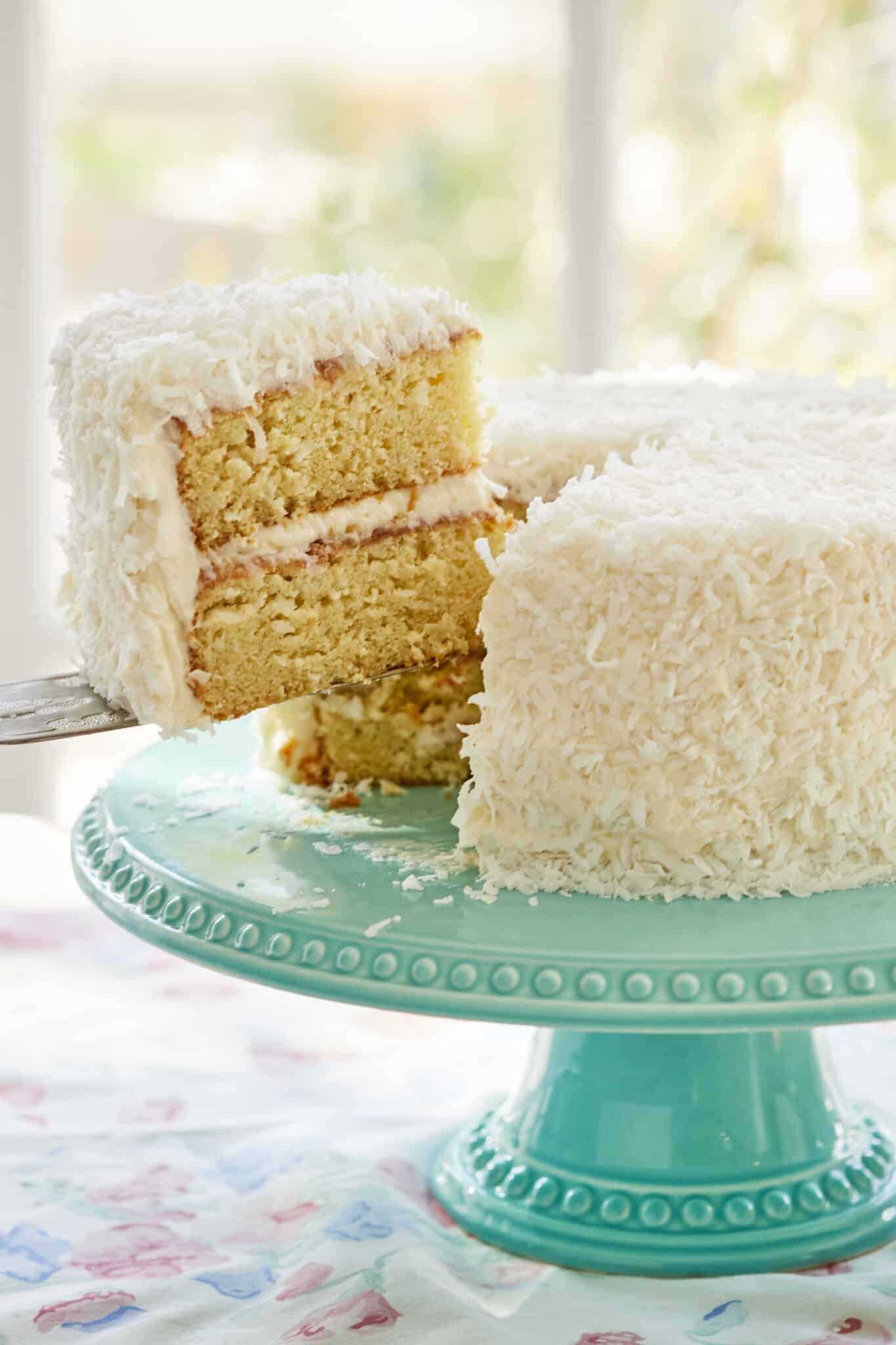
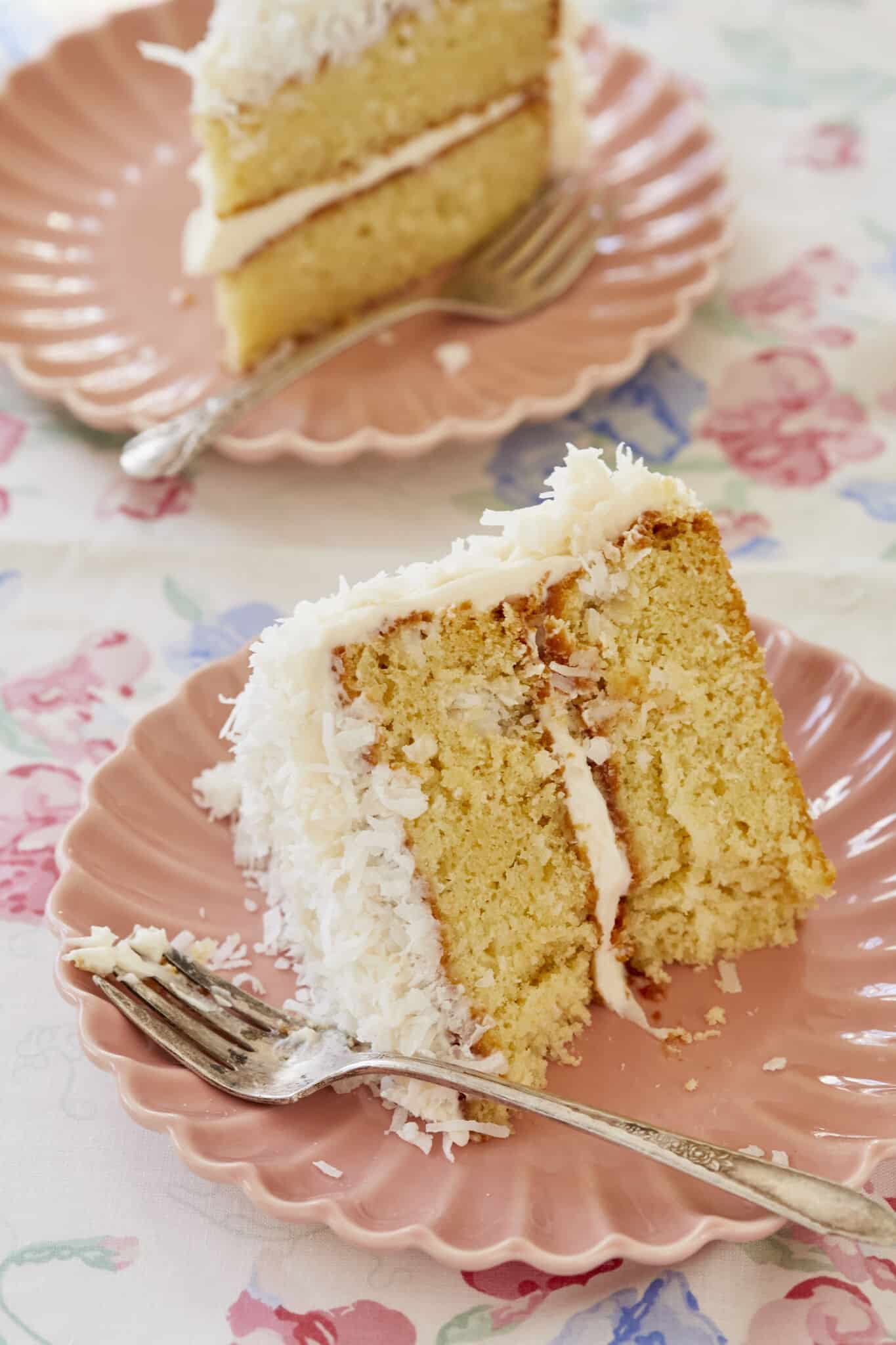
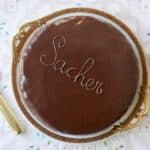


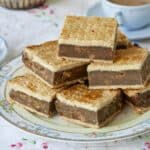
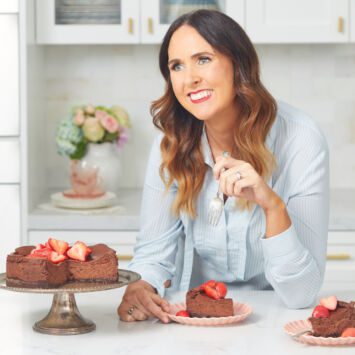

Just yum! I will try this recipe. I have a nice coconut cake recipe already, but I really am interested in how the buttermilk will do.
Thanks for this!
Hi Gemma, Could coconut milk be used in place of buttermilk?
Thank you for your beautiful recipes. I am looking forward to trying this. My mom (whose parents are from Ireland & Scotland) had a great recipe and she used 7 minute frosting with hers. We loved it and my brother had it for his birthday every year.
You truly are a blessing, Gemma.
This sounds amazing! Can I use a can of Cream of Coconut in place of the buttermilk?